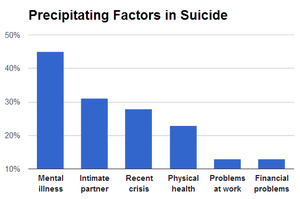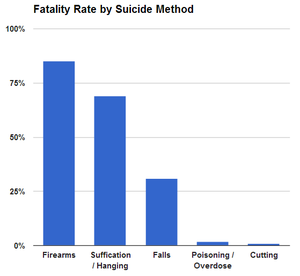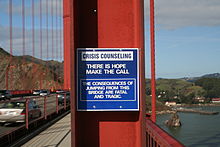
Suicide
About this schools Wikipedia selection
SOS Children volunteers helped choose articles and made other curriculum material SOS Child sponsorship is cool!
| Suicide | |
|---|---|
| Classification and external resources | |
 The Suicide by Édouard Manet 1877–1881 |
|
| ICD- 10 | X 60– X 84 |
| ICD- 9 | E950 |
| MedlinePlus | 001554 |
| eMedicine | article/288598 |
| MeSH | F01.145.126.980.875 |
Suicide (Latin suicidium, from sui caedere, "to kill oneself") is the act of intentionally causing one's own death. Suicide is often committed out of despair, the cause of which is frequently attributed to a mental disorder such as depression, bipolar disorder, schizophrenia, alcoholism, or drug abuse. Stress factors such as financial difficulties or troubles with interpersonal relationships often play a role. Efforts to prevent suicide include limiting access to firearms, treating mental illness and drug misuse, and improving economic development.
The most commonly used method of suicide varies by country and is partly related to availability. Common methods include: hanging, pesticide poisoning, and firearms. Around 800,000 to a million people die by suicide every year, making it the 10th leading cause of death worldwide. Rates are higher in men than in women, with males three to four times more likely to kill themselves than females. There are an estimated 10 to 20 million non-fatal attempted suicides every year. Attempts are more common in the young and females.
Views on suicide have been influenced by broad existential themes such as religion, honour, and the meaning of life. The Abrahamic religions traditionally consider suicide an offense towards God due to the belief in the sanctity of life. During the samurai era in Japan, seppuku was respected as a means of atonement for failure or as a form of protest. Sati, a now outlawed Hindu funeral practice, expected the widow to immolate herself on her husband's funeral pyre, either willingly or under pressure from the family and society.
Suicide and attempted suicide, while previously criminally punishable, is no longer in most Western countries. It remains a criminal offense in most Islamic countries. In the 20th and 21st centuries, suicide in the form of self-immolation has been used as a medium of protest, and kamikaze and suicide bombings have been used as a military or terrorist tactic.
Definitions
Suicide, also known as completed suicide, is the "act of taking one's own life". Attempted suicide or non fatal suicidal behaviour is self injury with the desire to end one's life that does not result in death. Assisted suicide is when one individual helps another bring about their own death indirectly via providing either advice or the means to the end. This is in contrast to euthanasia where another person takes a more active role in bringing about a persons death. Suicidal ideation is thinking of ending one's life.
Risk factors
Factors that affect the risk of suicide include psychiatric disorders, drug misuse, psychological states, cultural, family and social situations, and genetics. Mental illness and substance misuse frequently co-exists. Other risk factors include having previously attempted suicide, the ready availability of a means to commit the act, a family history of suicide, or the presence of traumatic brain injury. For example, suicide rates have been found to be greater in households with firearms than those without them. Socio-economic factors such as unemployment, poverty, homelessness, and discrimination may trigger suicidal thoughts. About 15–40% of people leave a suicide note. Genetics appears to account for between 38% and 55% of suicidal behaviors. War veterans have a higher risk of suicide due in part to higher rates of mental illness and physical health problems related to war.
Mental disorders
Mental disorders are often present at the time of suicide with estimates ranging from 27% to more than 90%. Of those who have been admitted to a psychiatric unit there life time risk of completed suicide is about 8.6%. Half of all people who die by suicide may have major depressive disorder; having this or one of the other mood disorders such as bipolar disorder increases the risk of suicide 20-fold. Other conditions implicated include schizophrenia (14%), personality disorders (14%), bipolar disorder, and posttraumatic stress disorder. About 5% of people with schizophrenia die of suicide. Eating disorders are another high risk condition.
A history of previous suicide attempts is the greatest predictor of eventual completion of suicide. Approximately 20% of suicides have had a previous attempt and of those who have attempted suicide 1% complete suicide within a year and more than 5% commit suicide after 10 years. While acts of self-harm are not seen as suicide attempts, the presence of self-injurious behaviour is related to increased suicide risk.
In approximately 80% of completed suicides the individuals has seen a physician within the year before their death, including 45% within the prior month. Approximately 25–40% of those who completed suicide had contact with mental health services in the prior year.
Substance use
Substance abuse is the second most common risk factor for suicide after major depression and bipolar disorder. Both chronic substance misuse as well as acute intoxication are associated. When combined with personal grief, such as bereavement, the risk is further increased. Additionally substance misuse is associated with mental health disorders.
Most people are under the influence of sedative-hypnotic drugs (such as alcohol or benzodiazepines) when they commit suicide with alcoholism present in between 15% and 61% of cases. Countries that have higher rates of alcohol use and a greater density of bars generally also have higher rates of suicide with this link being primarily related to distilled spirit use rather than total alcohol use. About 2.2–3.4% of those who have been treated for alcoholism at some point in their life die by suicide. Alcoholics who attempt suicide are usually male, older, and have tried to commit suicide in the past. Between 3 and 35% of deaths among those who use heroin are due to suicide (approximately 14 fold greater than those who do not use).
The misuse of cocaine and methamphetamines has a high correlation with suicide. In those who use cocaine the risk is greatest during the withdrawal phase. Those who used inhalants are also at significant risk with around 20% attempting suicide at some point and more than 65% considering it. Smoking cigarettes is associated with the risk of suicide. There is little evidence as to why this association exists; however it has been hypothesized that those who are predisposed to smoke are also predisposed to suicide, that smoking causes health problems which subsequently make people want to end their life, and that smoking affects brain chemistry causing a propensity for suicide. Cannibis however does not appear to independently increase the risk.
Problem gambling
Problem gambling is associated with increased suicidal ideation and attempts compared to the general population. Between 12 and 24% pathological gamblers attempt suicide. The rate of suicide among their wives is three times greater than that of the general population. Other factors that increase the risk in problem gamblers include mental illness, alcohol and drug misuse.
Medical conditions
There is an association between suicidality and physical health problems including: chronic pain, traumatic brain injury, cancer, those on hemodialysis, HIV, systemic lupus erythematosus, among others. The diagnosis of cancer approximately doubles the subsequent risk of suicide. The prevalence of increased suicidality persisted after adjusting for depressive illness and alcohol abuse. In people with more than one medical condition the risk was particularly high. In Japan health problems are listed as the primary justification for suicide.
Sleep disturbances such as insomnia and sleep apnea are risk factors for depression and suicide. In some instances the sleep disturbances may be a risk factor independent of depression. A number of other medical conditions may present with symptoms similar to mood disorders including: hypothyroidism, Alzheimer's, brain tumors, systemic lupus erythematosus, and adverse effects from a number of medications (such as beta blockers and steroids).
Psychosocial states
A number of psychological states increase the risk of suicide including: hopelessness, loss of pleasure in life, depression and anxiousness. A poor ability to solve problems, the loss of abilities one used to have, and poor impulse control also play a role. In older adults the perception of being a burden to others is important.
Recent life stresses such as a loss of a family member or friend, loss of a job, or social isolation (such as living alone) increases risk. Those who have never married are also at greater risk. Being religious may reduce one's risk of suicide. This has been attributed to the negative stance many religions take against suicide and to the greater connectedness religion may give. Muslims, among religious people, appear to have a lower rate.
Some may commit suicide to escape bullying or prejudice. A history of childhood sexual abuse and time spent in foster care are also risk factors. Sexual abuse is believed to contribute to about 20% of the overall risk.
An evolutionary explanation for suicide is that it may improve inclusive fitness. This may occur if the person committing suicide cannot have more children and takes resources away from relatives by staying alive. An objection is that deaths by healthy adolescents likely does not increase inclusive fitness. Adaptation to a very different ancestral environment may be maladaptive in the current one.
Poverty is associated with the risk of suicide. Increasing relative poverty compared to those around a person increases suicide risk. Over 200,000 farmers in India have committed suicide since 1997 partly due to issues of debt. In China suicide is three times as likely in rural regions as urban ones partly it is believed due to financial difficulties in this area of the country.
Rational
Rational suicide is the reasoned taking of one's own life, although some feel that suicide is never logical. The act of taking one's life for the benefit of others is known as altruistic suicide. An example of this is an elder ending their life to leave greater amounts of food for the younger people in the community. In some Eskimo culture this has been seen as an act of respect, courage, or wisdom.
A suicide attack is a political action where an attacker perpetrates violence against others which they understand will result in their own death. Some suicide bombers in an effort to obtain martyrdoms. Kamikaze missions where carried out as a duty to a higher cause or moral obligation. Murder–suicide is an act of homicide followed within a week by suicide of the person who carried out the act. Mass suicides are often performed under social pressure where members give up autonomy to a leader. Mass suicides can take place with as few as two people, often referred to as a suicide pact.
In extenuating situations where continuing to live would be intolerable, some people use suicide as a means of escape. Some inmates in Nazi concentration camps are known to have killed themselves by deliberately touching the electrified fences.
Methods
The leading method of suicide varies between countries. The leading methods in different regions include hanging, pesticide poisoning, and firearms. These differences are believed to be in part due to availability of the different methods. A review of 56 countries found that hanging was the most common method in most of the countries, accounting for 53% of the male suicides and 39% of the female suicides. Worldwide 30% of suicides are from pesticides. The use of this method however varies markedly from 4% in Europe to more than 50% in the Pacific region. It is also common in Latin America due to easy access within the farming populations. In many countries, drug overdoses account for approximately 60% of suicides among women and 30% among men. Many are unplanned and occur during an acute period of ambivalence. The death rate varies by method: firearms 80-90%, drowning 65-80%, hanging 60-85%, car exhaust 40-60%, jumping 35-60%, charcoal burning 40-50%, pesticides 6-75%, medication overdose 1.5-4%. The most common attempted methods of suicide differ from the most common successful methods with up to 85% of attempts via drug overdose in the developed world.
In the United States 57% of suicides involve the use of firearms with this method being somewhat more common in men than women. The next most common cause was hanging in males and self poisoning in females. Together these methods comprised about 40% of U.S. suicides. In Switzerland, where nearly everyone owns a firearm, the greatest number of suicides are by hanging. Jumping to one's death is common in both Hong Kong and Singapore at 50% and 80% respectively. In China the consumption of pesticides is the most common method. In Japan self disembowelment known as seppuku or hara-kiri still occurs however hanging is the most common.
Pathophysiology
There is no known unifying underlying pathophysiology for either suicide or depression. It is however believed to result from an interplay of behavioural, socio-environmental and psychiatric factors.
Low levels of brain-derived neurotrophic factor (BDNF) are both directly associated with suicide and indirectly associated through its role in major depression, post-traumatic stress disorder, schizophrenia and obsessive-compulsive disorder. Post-mortem studies have found reduced levels of BDNF in the hippocampus and prefrontal cortex, in those with and without psychiatric conditions. Serotonin, a brain neurotransmitter, is believed to be low in those who commit suicide. This is partly based on evidence of increased levels of 5-HT2A receptors found after death. Other evidence includes reduced levels of a breakdown product of serotonin, 5-hydroxyindoleacetic acid, in the cerebral spinal fluid. Direct evidence is however hard to gather. Epigenetics, the study of changes in genetic expression in response to environmental factors which do not alter the underlying DNA, is also believed to play a role in determining suicide risk.
Prevention
Suicide prevention is a term used for the collective efforts to reduce the incidence of suicide through preventive measures. Reducing access to certain methods, such as firearms or toxins reduces the risk. Other measures include reducing access to charcoal and barriers on bridges and subway platforms. Treatment of drug and alcohol addiction, depression, and those who have attempted suicide in the past may also be effective. Some have proposed reducing access to alcohol as a preventative strategy (such as reducing the number of bars). Although crisis hotlines are common there is little evidence to support or refute their effectiveness. In young adults who have recently thought about suicide, cognitive behavioural therapy appears to improve outcomes. Economic development through its ability to reduce poverty may be able to decrease suicide rates. Efforts to increase social connection especially in elderly males may be effective.
Screening
There is little data on the effects of screening the general population on the ultimate rate of suicide. As there is a high rate of people who test positive via these tool that are not at risk of suicide there are concerns that screening may significantly increase mental health care resource utilization. Assessing those at high risk however is recommended. Asking about suicidality does not appear to increase the risk.
Mental illness
In those with mental health problems a number of treatments may reduce the risk of suicide. Those who are actively suicidal may be admitted to psychiatric care either voluntarily or involuntarily. Possessions that may be used to harm oneself are typically removed. Some clinicians get patients to sign suicide prevention contracts where they agree to not harm themselves if released. Evidence however does not support a significant effect from this practice. If a person is at low risk out-patient mental health treatment may be arranged. Short-term hospitalization has not been found to be more effective than community care for improving outcomes in those with borderline personality disorder who are chronically suicidal.
There is tentative evidence that psychotherapy, specifically, dialectical behaviour therapy reduces suicidality in adolescents as well as those with borderline personality disorder. Evidence however has not found a decrease in completed suicides.
There is controversy around the benefit versus harm of antidepressants. In young persons the newer antidepressants such as SSRIs appears to increased risk of suicidality from 25 per 1000 to 40 per 1000. In older persons however they might decrease the risk. Lithium appears effective at lowering the risk in those with bipolar disorder and unipolar depression to nearly the same levels as the general population.
Epidemiology
Approximately 0.5% to 1.4% of people end their life by suicide. Globally, as of 2008/2009, suicide is the tenth leading cause of death with about 800,000 to one million people dying annually, giving a mortality rate of 11.6 per 100,000 persons per year. Rates of suicide have increased by 60% from the 1960s to 2012, with these increases seen primarily in the developing world. For every suicide that results in death there are between 10 and 40 attempted suicides.
Suicide rates differ significantly between countries and over time. As a percentage of deaths in 2008 it was: Africa 0.5%, South-East Asia 1.9% Americas 1.2% and Europe 1.4%. Rates per 100,000 where: Australia 8.6, Canada 11.1, China 12.7, India 23.2, United Kingdom 7.6, United States 11.4. It is ranked as the 10th leading cause of death in the United States in 2009 at about 36,000 cases a year. And about 650,000 people are seen in the emergency department yearly there due to attempting suicide. Lithuania, Japan and Hungary has the highest rates. The countries with the greatest absolute numbers of suicides are China and India accounting for over half the total. In China suicide is the 5th leading cause of death.
Gender
In the Western world, males die three to four times more often by means of suicide than do females, although females attempt suicide four times more often. This has been attributed to males using more lethal means to end their lives. This difference is even more pronounced in those over the age of 65 with tenfold more males committing suicide than females. China has one of the highest female suicide rates in the world and is the only country where it is higher than that of men (ratio of 0.9). In the Eastern Mediterranean suicide rates are nearly equivalent between males and females. For women the highest rate of suicide is found in South Korea at 22 per 100,000, with high rates in South-East Asia and the Western Pacific generally.
Age
In many countries the rate of suicide is highest in the middle aged or elderly. The absolute numbers of suicides however is greatest in those between 15 and 29 years old due to the number of people in this age group. In the United States it is greatest in caucasian men older than 80 years even though younger people more frequently attempt suicide. It is the second most common cause of death in adolescents and in young males is second only to accidental death. In young males in the developed world it is the cause of nearly 30% of mortality. In the developing world rates are similar but it makes up a smaller proportion of overall deaths due to higher rates of death from other types of trauma. In South-East Asia in contrast to other areas of the world, deaths from suicide occur at a greater in young females than elderly females.
History
In ancient Athens, a person who committed suicide without the approval of the state was denied the honours of a normal burial. The person would be buried alone, on the outskirts of the city, without a headstone or marker. In Ancient Greece and Rome suicide was deemed to be an acceptable method to deal with military defeat. In Ancient Rome while suicide was initially permitted it was latter deemed a crime against the state due to its economic costs. A criminal ordinance issued by Louis XIV in 1670 was far more severe in its punishment: the dead person's body was drawn through the streets, face down, and then hung or thrown on a garbage heap. Additionally, all of the person's property was confiscated. Historically in the Christian church people who attempted suicide were excommunicated and those who died by suicide were buried outside consecrated graveyards. In the late 19th century in Great Britain attempted suicide was deemed to be equivalent to attempted murder and could be punished by hanging. In 19th century Europe the act of suicide shifted from being viewed as cause by sin to being caused by insanity.
Social and culture
Legislation
In most Western countries, suicide is no longer a crime, it however was in most Western European countries from the Middle Ages until at least the 1800s. Many Islamic countries label it a criminal offense.
In Australia suicide is not a crime. It however is a crime to counsel, incite, or aid and abet another in attempting to commit suicide, and the law explicitly allows any person to use "such force as may reasonably be necessary" to prevent another from committing suicide. The Northern Territory of Australia briefly had legal physician-assisted suicide from 1996 to 1997.
No country in Europe currently considers suicide or attempted suicide to be a crime. England and Wales decriminalized suicide via the Suicide Act 1961 and the Republic of Ireland in 1993. The word "commit" was used in reference to it being illegal however many organisations have stopped it because of the negative connotation.
In India, suicide is illegal and surviving family may face legal difficulties. In Germany, active euthanasia is illegal and anyone present during suicide may be prosecuted for failure to render aid in an emergency. Switzerland has recently taken steps to legalize assisted suicide for the chronically mentally ill. The high court in Lausanne, in a 2006 ruling, granted an anonymous individual with longstanding psychiatric difficulties the right to end his own life.
In the United States, suicide is not illegal but may be associated with penalties for those who attempt it. Physician-assisted suicide is legal in the states of Oregon and Washington.
Religious views
In most forms of Christianity, suicide is considered a sin, based mainly on the writings of influential Christian thinkers of the Middle Ages, such as St. Augustine and St. Thomas Aquinas; but suicide was not considered a sin under the Byzantine Christian code of Justinian, for instance. In Catholic doctrine, the argument is based on the commandment "Thou shalt not kill" (made applicable under the New Covenant by Jesus in Matthew 19:18), as well as the idea that life is a gift given by God which should not be spurned, and that suicide is against the "natural order" and thus interferes with God's master plan for the world. However, it is believed that mental illness or grave fear of suffering diminishes the responsibility of the one completing suicide. Counter-arguments include the following: that the sixth commandment is more accurately translated as "thou shalt not murder", not necessarily applying to the self; that God has given free will to humans; that taking one's own life no more violates God's Law than does curing a disease; and that a number of suicides by followers of God are recorded in the Bible with no dire condemnation.
Judaism focuses on the importance of valuing this life, and as such, suicide is tantamount to denying God's goodness in the world. Despite this, under extreme circumstances when there has seemed no choice but to either be killed or forced to betray their religion, Jews have committed individual suicide or mass suicide (see Masada, First French persecution of the Jews, and York Castle for examples) and as a grim reminder there is even a prayer in the Jewish liturgy for "when the knife is at the throat", for those dying "to sanctify God's Name" (see Martyrdom). These acts have received mixed responses by Jewish authorities, regarded both as examples of heroic martyrdom, while others state that it was wrong for them to take their own lives in anticipation of martyrdom.
Suicide is not allowed in Islam. In Hinduism, suicide is generally frowned upon and is considered equally sinful as murdering another in contemporary Hindu society. Hindu Scriptures state that one who commits suicide will become part of the spirit world, wandering earth until the time one would have otherwise died, had one not committed suicide. However, Hinduism accept a man's right to end one's life through the non-violent practice of fasting to death, termed Prayopavesa. But Prayopavesa is strictly restricted to people who have no desire or ambition left, and no responsibilities remaining in this life. Jainism has a similar practice named Santhara. Sati, or self-immolation by widows was prevalent in Hindu society during the Middle Ages.
Philosophy
A number of questions are raised within the philosophy of suicide, included what constitutes suicide, whether or not suicide can be a rational choice, and the moral permissibility of suicide. Philosophical arguments in regard to whether or not suicide can be morally acceptable range from strong opposition, (viewing suicide as unethical and immoral), through to perceptions of suicide as a sacrosanct right for anyone (even a young and healthy person) who believes they have rationally and conscientiously come to the decision to end their own lives. Opponents to suicide include Christian philosophers such as Augustine of Hippo and Thomas Aquinas, Immanuel Kant and, arguably, John Stuart Mill – Mill's focus on the importance of liberty and autonomy meant that he rejected choices which would prevent a person from making future autonomous decisions. Others view suicide as a legitimate matter of personal choice. Supporters of this position maintain that no one should be forced to suffer against their will, particularly from conditions such as incurable disease, mental illness, and old age that have no possibility of improvement. They reject the belief that suicide is always irrational, arguing instead that it can be a valid last resort for those enduring major pain or trauma. A stronger stance would argue that people should be allowed to autonomously choose to die regardless of whether they are suffering. Notable supporters of this school of thought include Scottish empiricist David Hume and American bioethicist Jacob Appel.
Advocacy
Advocacy of suicide has occurred in many cultures and subcultures. The Japanese military during World War II encouraged and glorified kamikaze attacks, and Japanese society as a whole has been described as suicide "tolerant" (see Suicide in Japan).
Internet searches for information on suicide return webpages that 10-30% of the time encourage or facilitate, suicide attempts. There is some concern that such sites may push those predisposed over the edge. Some people form suicide pacts online, either with preexisting friends or people than have recently encountered in chat rooms or message boards. The Internet however may also help prevent suicide by providing a social group for those who are isolated.
Locations
Some landmarks have become known for high levels of suicide attempts. These include San Francisco's Golden Gate Bridge, Japan's Aokigahara Forest, England's Beachy Head, and Toronto's Bloor Street Viaduct.
As of 2010 the Golden Gate Bridge has had more than 1,300 commit suicide by jumping since its construction in 1937. Many locations where suicide is common have constructed barriers to prevent it. This includes the Luminous Veil in Toronto, and barriers at the Eiffel Tower in Paris and Empire State Building in New York. As of 2011 a barrier is being constructed for the Golden Gate Bridge. They appear to be generally very effective.
Other species
As suicide requires a willful attempt to die some feel it therefore cannot be said to occur in non human animals. Suicide behaviour has been observed in salmonella seeking to overcome competing bacteria by triggering an immune system response against them. Suicidal defences by workers are also noted in a Brazilian ant Forelius pusillus where a small group of ants leaves the security of the nest after sealing the entrance from the outside each evening.
Pea aphids, when threatened by a ladybug, can explode themselves, scattering and protecting their brethren and sometimes even killing the lady bug. Some species of termites have soldiers that explode, covering their enemies with sticky goo.
There have been anecdotal reports of dogs, horses, and dolphins committing suicide, but with little conclusive evidence. There has been little scientific study of animal suicide.
Notable cases
An example of mass suicide is the 1978 " Jonestown" cult suicide, in which 918 members of the Peoples Temple, an American cult led by Jim Jones, ended their lives by drinking grape Flavor Aid laced with cyanide. Over 10,000 Japanese civilians committed suicide in the last days of the Battle of Saipan in 1944, some jumping from "Suicide Cliff" and "Banzai Cliff".
The 1981 hunger strikes, led by Bobby Sands, resulted in 10 deaths. The cause of death was recorded as "starvation, self-imposed" rather than suicide by the coroner; this was modified to simply "starvation" on the death certificates after protest from the dead striker's families. Erwin Rommel during World War II was found to have foreknowledge of the July 20 Plot on Hitler's life and was threatened with public trial, execution, and reprisals on his family unless he took his own life.












